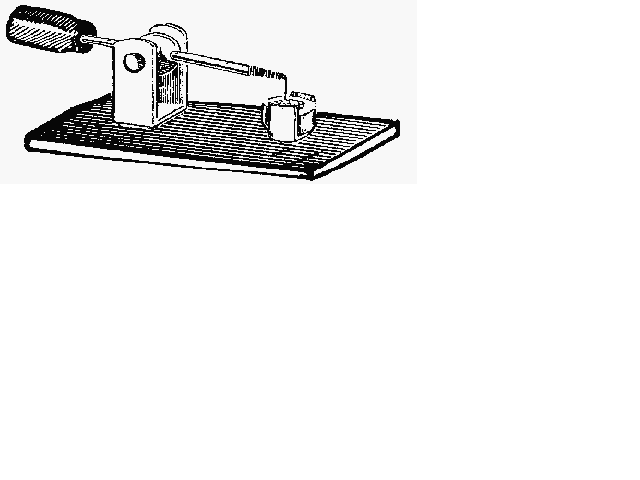Journeys to the Past
by Wayne Thalls, KB6KN
My wife thinks it is a phobia? Do you also find yourself
looking for antennas on houses and cars? Perhaps I am doubly cursed.
When I travel, I find myself on the look-out for historical
connections to electronic communications.
I first became interested in amateur radio during my junior
high school days. Following World War 2 military service I pursued a
career in electronics and communications. Combine this background
with a long-time interest in historical research, and perhaps it has
become obsessive.
LIVING HISTORY
Not long ago my wife and I spent a week in the Midwest. We were
there for a 50-year reunion of my WW2 Army Air Corps outfit. I had not
seen any of those fellows since our 1944 graduation from an intensive
year-long program of meteorological studies at the University of
Iowa. The bonds of a half century ago were quickly renewed--but
that's another story.
reunion of my WW2 Army Air Corps outfit. I had not
seen any of those fellows since our 1944 graduation from an intensive
year-long program of meteorological studies at the University of
Iowa. The bonds of a half century ago were quickly renewed--but
that's another story.
The nostalgic mood was set. As we toured, before and after the
reunion, we encountered many gems of radio-related history.
Our first night was spent at a hotel near the Cedar Rapids
airport. Close by was the old  Collins Radio plant. That company was founded by Arthur
Collins, an avid ham radio enthusiast (9CXX) from his
high-school days until his death a few years ago. The firm, now part
of Rockwell International, was for decades THE source of top-notch
ham radio gear. Collins also produced commercial and military
equipment. In the Air Corps I used the Collins ART-13 airborne high
frequency cw and voice transmitter. That unit became became a ham
favorite on the post-war surplus market.
Collins Radio plant. That company was founded by Arthur
Collins, an avid ham radio enthusiast (9CXX) from his
high-school days until his death a few years ago. The firm, now part
of Rockwell International, was for decades THE source of top-notch
ham radio gear. Collins also produced commercial and military
equipment. In the Air Corps I used the Collins ART-13 airborne high
frequency cw and voice transmitter. That unit became became a ham
favorite on the post-war surplus market.
 The following morning we drove the short
distance to Iowa City. After checking in at our hotel, we made a
leisurely walking tour of the university campus. Memories of those
long-ago days were recalled, as we visited buildings where I had
attended classes. Lots of laboratory time had been spent in the
university Physics Building. It was here that physicist James Van
Allen conducted post-war studies of the radiation belts surrounding
the earth. The resulting knowledge of the Van Allen Belt has been an
essential element in the development of present-day communication
satellites, and other space technology. Growth of the Iowa Physics
Department has been accommodated by a new structure, named for Dr.
Van Allen.
The following morning we drove the short
distance to Iowa City. After checking in at our hotel, we made a
leisurely walking tour of the university campus. Memories of those
long-ago days were recalled, as we visited buildings where I had
attended classes. Lots of laboratory time had been spent in the
university Physics Building. It was here that physicist James Van
Allen conducted post-war studies of the radiation belts surrounding
the earth. The resulting knowledge of the Van Allen Belt has been an
essential element in the development of present-day communication
satellites, and other space technology. Growth of the Iowa Physics
Department has been accommodated by a new structure, named for Dr.
Van Allen.
There were other nuggets. In 1922, the State University of Iowa
station WSUI became the first educational radio station west
of the Mississippi. The station still provides programming to the
campus and the community. In 1932 the university took to the air with
W9XK , the first regularly operating educational TV station in
the world. Such ham-like calls were once assigned to experimental
stations.
RADIO CAME OF AGE
Following the reunion, we spent several days touring
surrounding areas. We visited
nearby West Branch--the childhood home of Herbert Hoover, 31st President of
the United States. The Hoover Presidential Library and Museum are
located there. What possible connection to ham radio could this have,
you ask?
West Branch--the childhood home of Herbert Hoover, 31st President of
the United States. The Hoover Presidential Library and Museum are
located there. What possible connection to ham radio could this have,
you ask?
Hoover had a long-time interest in radio. It may have been
fueled in part by his son, Herbert II, also known as Pete. He was
licensed as 6SR around 1919, while he was a Stanford
University student. One museum exhibit includes a photo of Pete
Hoover at the controls of his 1920 era ham station. Herbert Hoover
III W6ZH, grandson of the former President, is still on the
air from southern California. During the 1960s, he was president of
the American Radio Relay League.
Herbert Sr. served as Secretary of Commerce from 1921 until
1927. That agency had jurisdiction over U.S. non-military radio
operations until 1934, when the FCC was established. During his
tenure Secretary Hoover brought order to the chaotic and virtually
unregulated field of radio communication. Frequency allocation
procedures were established, and stringent licensing requirements
were introduced for all classes of stations. Displayed in the museum
as an example is a 1922 Amateur First Class license issued to a
midwestern ham.
Hoover was nominated for the Presidency in 1927. He became the
first candidate to make extensive use of radio broadcasting in his
bid for office. He was also the first U.S. President to appear in a
TV broadcast. He became the first chief executive to have a telephone
in the oval office. The instrument now rests on the desk in a museum
re-creation of his White House office.
BEFORE SILICON VALLEY
We spent several enjoyable days touring along the Mississippi
River--still a major marine artery. One leisurely river-side drive
led us to the lovely old city of Galena, Illinois. Galena was an
early boom town in the Northwest Territory. In the 1840s and '50s, it
was the largest city in Illinois. Larger by far--and wealthier--than
Chicago. Numerous pre-civil war era buildings line the downtown
streets. A remarkable 85 percent of the town structures are on the
National Register of Historic Sites.
What was the source of all this wealth? In the mid 17th
century, French traders discovered extensive deposits of lead in the
area. The principal ore of lead is lead sulfide--also called galena.
This became the name of the mining town. Mining continued until the
1950s, when growing environmental concerns sharply curtailed the
world-wide demand for lead.
Ulysses S. Grant was a resident of Galena, when he was
re-called to active duty with the Union army during the Civil War.
During this conflict some revolutionary innovations were introduced
to warfare. This was the first time that aircraft were used in
combat. Hot air balloons were utilized for artillery spotting and
other surveillance activities--the first spies in the sky. Electronic
digital communication was also adopted by the army. Samuel Morse's
telegraph proved a boon to newspaper correspondents at the battle
sites as well. The citizens back home often received battle details
within hours.
Is there a co nnection here with electronic
communications? Galena--the mineral--was perhaps the most popular
material to be used as a detector in early crystal-set radios. It was
the fore-runner of modern-day semiconductors--the devices which bring
the promise of a futuristic electronic information highway.
Galena--the city--still evokes memories of the 1870s, when rivers
were the super highways.
nnection here with electronic
communications? Galena--the mineral--was perhaps the most popular
material to be used as a detector in early crystal-set radios. It was
the fore-runner of modern-day semiconductors--the devices which bring
the promise of a futuristic electronic information highway.
Galena--the city--still evokes memories of the 1870s, when rivers
were the super highways.
Some sites for more information:
Hoover Library
and Museum
WA3KEY Virtual
Collins Radio Museum
The XTAL Set
Society
Return to Index
6/8/00
 reunion of my WW2 Army Air Corps outfit. I had not
seen any of those fellows since our 1944 graduation from an intensive
year-long program of meteorological studies at the University of
Iowa. The bonds of a half century ago were quickly renewed--but
that's another story.
reunion of my WW2 Army Air Corps outfit. I had not
seen any of those fellows since our 1944 graduation from an intensive
year-long program of meteorological studies at the University of
Iowa. The bonds of a half century ago were quickly renewed--but
that's another story. Collins Radio plant. That company was founded by Arthur
Collins, an avid ham radio enthusiast (9CXX) from his
high-school days until his death a few years ago. The firm, now part
of Rockwell International, was for decades THE source of top-notch
ham radio gear. Collins also produced commercial and military
equipment. In the Air Corps I used the Collins ART-13 airborne high
frequency cw and voice transmitter. That unit became became a ham
favorite on the post-war surplus market.
Collins Radio plant. That company was founded by Arthur
Collins, an avid ham radio enthusiast (9CXX) from his
high-school days until his death a few years ago. The firm, now part
of Rockwell International, was for decades THE source of top-notch
ham radio gear. Collins also produced commercial and military
equipment. In the Air Corps I used the Collins ART-13 airborne high
frequency cw and voice transmitter. That unit became became a ham
favorite on the post-war surplus market. The following morning we drove the short
distance to Iowa City. After checking in at our hotel, we made a
leisurely walking tour of the university campus. Memories of those
long-ago days were recalled, as we visited buildings where I had
attended classes. Lots of laboratory time had been spent in the
university Physics Building. It was here that physicist James Van
Allen conducted post-war studies of the radiation belts surrounding
the earth. The resulting knowledge of the Van Allen Belt has been an
essential element in the development of present-day communication
satellites, and other space technology. Growth of the Iowa Physics
Department has been accommodated by a new structure, named for Dr.
Van Allen.
The following morning we drove the short
distance to Iowa City. After checking in at our hotel, we made a
leisurely walking tour of the university campus. Memories of those
long-ago days were recalled, as we visited buildings where I had
attended classes. Lots of laboratory time had been spent in the
university Physics Building. It was here that physicist James Van
Allen conducted post-war studies of the radiation belts surrounding
the earth. The resulting knowledge of the Van Allen Belt has been an
essential element in the development of present-day communication
satellites, and other space technology. Growth of the Iowa Physics
Department has been accommodated by a new structure, named for Dr.
Van Allen.
 nnection here with electronic
communications? Galena--the mineral--was perhaps the most popular
material to be used as a detector in early crystal-set radios. It was
the fore-runner of modern-day semiconductors--the devices which bring
the promise of a futuristic electronic information highway.
Galena--the city--still evokes memories of the 1870s, when rivers
were the super highways.
nnection here with electronic
communications? Galena--the mineral--was perhaps the most popular
material to be used as a detector in early crystal-set radios. It was
the fore-runner of modern-day semiconductors--the devices which bring
the promise of a futuristic electronic information highway.
Galena--the city--still evokes memories of the 1870s, when rivers
were the super highways.